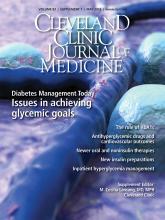ABSTRACT
Inpatient hyperglycemia is common and is associated with an increased risk of hospital complications, higher health-care resource utilization, and higher in-hospital mortality rates. Appropriate glycemic control strategies can reduce these risks, although hypoglycemia is a concern. In critically ill patients, intravenous (IV) insulin is most appropriate, with a starting threshold no higher than 180 mg/dL. Once IV insulin is started, the glucose level should be maintained between 140 and 180 mg/dL. In noncritically ill patients, basal-bolus regimens with basal, prandial, and correction components are preferred for those with good nutritional intake. In contrast, a single dose of long-acting insulin plus correction insulin is preferred for patients with poor or no oral intake. Measuring hemoglobin A1c at admission is important to assess glycemic control and to tailor the treatment regimen at discharge.
Footnotes
Dr. Umpierrez is supported in part by research grants from the American Diabetes Association (1-14-LLY-36), PHS grant UL1 RR025008 from the Clinical Translational Science Award Program (M01 RR-00039), and grants from the National Institutes of Health and the National Center for Research Resources. He has received unrestricted research support for inpatient studies (at Emory University) from Sanofi, Merck, Novo Nordisk, and Boehringer Ingelheim, and has received consulting fees and/or honoraria for membership on advisory boards from Novo Nordisk, Sanofi, Merck, Boehringer Ingelheim, and Regeneron.
Dr. Lansang reported that she has no financial interests or relationships that pose a potential conflict of interest with this article.
- Copyright © 2016 The Cleveland Clinic Foundation. All Rights Reserved.
- M. Cecilia Lansang, MD, MPH
- Guillermo E. Umpierrez, MD, CDE⇑
- Correspondence:
Guillermo E. Umpierrez, MD, CDE, Professor of Medicine, Director, Grady Hospital Research Unit, A-CTSI, Emory University, Section Head, Diabetes & Endocrinology, Grady Health System, 80 Jesse Hill Jr. Drive SE, Atlanta, Georgia 30303; geumpie{at}emory.edu
ABSTRACT
Inpatient hyperglycemia is common and is associated with an increased risk of hospital complications, higher health-care resource utilization, and higher in-hospital mortality rates. Appropriate glycemic control strategies can reduce these risks, although hypoglycemia is a concern. In critically ill patients, intravenous (IV) insulin is most appropriate, with a starting threshold no higher than 180 mg/dL. Once IV insulin is started, the glucose level should be maintained between 140 and 180 mg/dL. In noncritically ill patients, basal-bolus regimens with basal, prandial, and correction components are preferred for those with good nutritional intake. In contrast, a single dose of long-acting insulin plus correction insulin is preferred for patients with poor or no oral intake. Measuring hemoglobin A1c at admission is important to assess glycemic control and to tailor the treatment regimen at discharge.
Footnotes
Dr. Umpierrez is supported in part by research grants from the American Diabetes Association (1-14-LLY-36), PHS grant UL1 RR025008 from the Clinical Translational Science Award Program (M01 RR-00039), and grants from the National Institutes of Health and the National Center for Research Resources. He has received unrestricted research support for inpatient studies (at Emory University) from Sanofi, Merck, Novo Nordisk, and Boehringer Ingelheim, and has received consulting fees and/or honoraria for membership on advisory boards from Novo Nordisk, Sanofi, Merck, Boehringer Ingelheim, and Regeneron.
Dr. Lansang reported that she has no financial interests or relationships that pose a potential conflict of interest with this article.
- Copyright © 2016 The Cleveland Clinic Foundation. All Rights Reserved.






